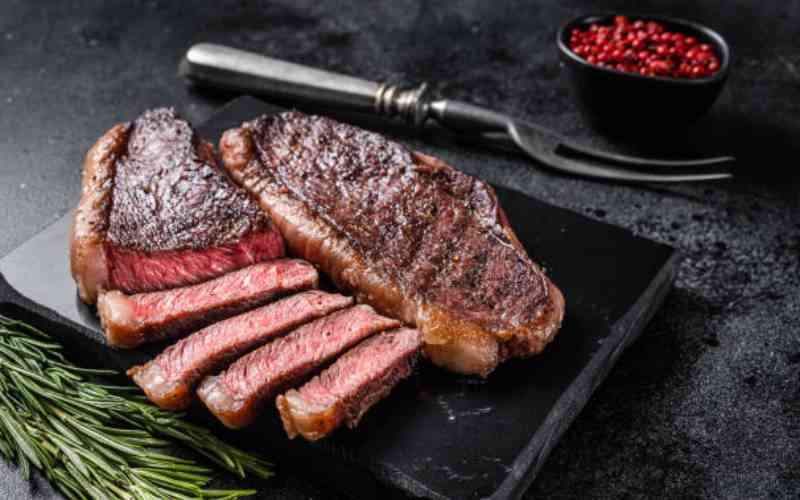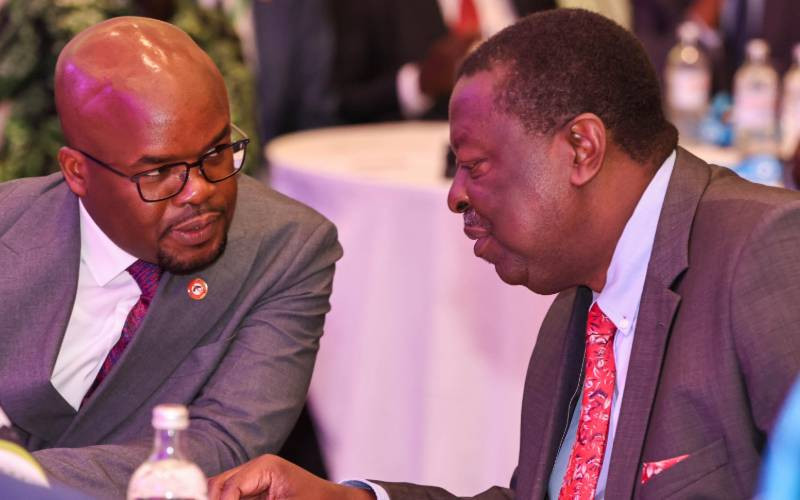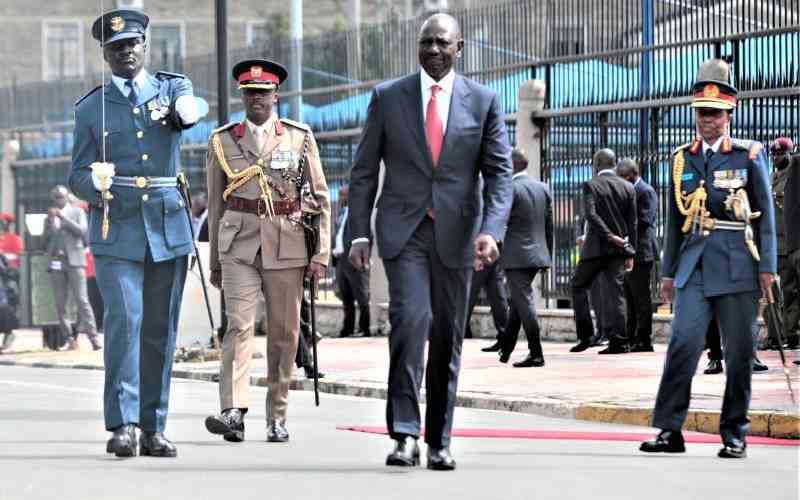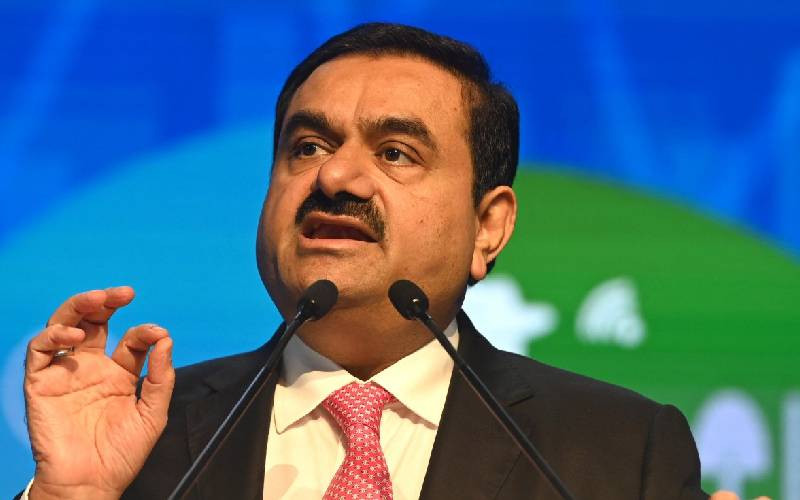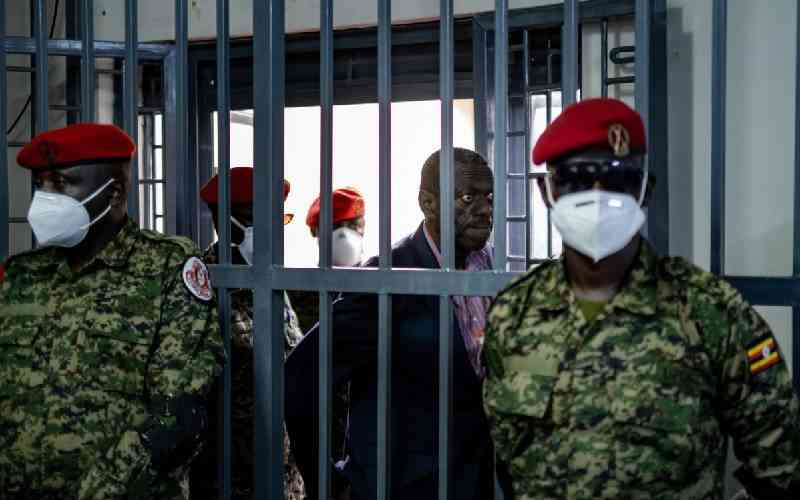 |
|
Shiseso Catholic Parish Father Kulumbani Odhiambo blesses the body of the late Adriano Aluchio before leading the burial service at Shikhombero village in Ikolomani Constituency. The late Aluchio body was buried while seated following traditions that demands dead to be buried while seated among the Angusu clan of the Idakho in Kakamega County. The Practice has put community loggerheads with Church leaders. By Benjamin Sakwa |
Kakamega; Kenya: How do you bury a revered village elder, traditional medicine healer and renowned farmer? In a unique way, villagers of Eshikombelo in Kakamega County would say, that is if that person was Mzee Adriano Aluchio, whose final send off on Monday was like no other.
On Monday, hundreds of curious people flocked Mzee Adriano’s home to pay their last respects for the 62-year-old. But most of them wanted to witness the unique Idakho burial ceremony.
The Bukusu, Idakho, Tachoni and Kabras sub-tribes of the Luhya community believe that burying the dead in a sitting position is a sign of respect.
“We found these traditions in place and have to live with them. For the dead to fit into the coffin, the elders must hold a special conversation with them before they are buried,” says Mzee Museve Mwidakho.
Mwidakho, an elder from the Angusu clan of the Idakho sub-tribe from which Mzee Aluchio hailed from, said the practice is meant to connect the living and the dead. This practice, he says, was started by Nabongo Mumia of the Wanga community and has since been copied by other sub-tribes. “Burying the dead in a sitting position sends away evil spirits,” he said.
The Angusu believe Mzee Adriano will be watching over his family even in his death.
Lawrence Munai, another Angusu elder, says after Mzee Adriano was buried, bulls were taken round his grave “to gorge away dark forces”.
“Mzee Adriano was accorded the perfect send-off, a befitting burial for a man of his social stature. This connects him with the world of our ancestors,” says Munai.
Most Luhya sub-tribes have their own unique burial rites that are either performed in public or private ceremonies. Laban Sindani, a Kabras elder, says his sub-tribe still conducts ancient customary burial ceremonies.
Strict rituals
“Khuuyia is the name of the traditional burial of the Kabras. Nowadays, it is conducted for those who give instructions when they are still alive on how they wish be buried.
Before their death, any person who wants the Khuuyia conducted chooses a bull to be slaughtered by one of his sons when his time comes,” Sindani told The Standard on Sunday.
The Kabras elder says people who believe in Khuuyia rites are usually buried in a house chosen by them before their deaths.
“This house is called shiro and no one is allowed to stay in it. Before the white men came and introduced hospitals, a person nearing his death, either due to old age or illness, was taken to the shiro. Movement of dead bodies is a taboo in our community,” Sindani said.
With the Khuuyia, the dead is either sat vertically or laid horizontally. In the former, both hands are rested on the cheeks while in the later, one hand is rested on the lower cheek and the other on the thigh.
Stay informed. Subscribe to our newsletter
Burial is conducted on the second day after death.
Sindani says that when one is buried in the horizontal position, the body should face the entrance to the shiro. “The grave is dug at night and soil thrown outside through a makeshift opening on the wall of the house, not through the door or window,” he said.
The chosen bull must be killed with one strike on the head with a club. It should be killed facing the entrance to the shiro and must fall on the right side of the hut. Rituals are only done by people who support and follow the culture.
“The first grandson in the sub-clan climbs the shiro as one elder beats a small drum while another sprinkles milk on the grave using a tail belonging to the one of the deceased’s family’s cattle,” Sindani said.
The milk used must be from the deceased’s oldest cow. If the deceased did not own any cow, the milk is obtained from a brother’s cow.
The dead bull is then skinned and the meat is only eaten by a few people.
“Those who carry home the meat need to have slaughtered a cow or a bull to the deceased relatives in the past. If by mistake one partakes the beef and does not qualify, they will be haunted by evil spirits. The corpse is buried naked. Its private parts are cut off and kept on a stick tied on its waist before the corpse is lowered into the grave,” he said.
The body is wrapped in a skin from a slaughtered bull and is buried with the head, which is covered with a pot, sticking out of the grave.
When the body is rotten completely, the shiro is pulled down by the elders who conducted the burial. The shiro must fall down at a go. If it does not, it means deceased is “not really dead” and someone close to him could follow suit, Sindani said.
On the burial day, traditional dances are held as a special horn blown, which is kept in the hut between the roof and the walls, is blown. To signal death, the horn falls on the ground on its own.
“Blowing of the horn is done by a chosen individual. If any else does so, that person dies. A young boy died once because he blew the horn when he was not the one supposed to,” Sindani says.
Adulterous wives are not permitted in such ceremonies lest they die instantly.
‘Archaic and unchristian’
Among the Bukusu, the Omusenamse, a wise person who follows traditions strictly, has to be dressed in Ikutusi and Ikutwa (traditional attire) and Omusila (flywhisk). They must hold a Indabusi (club) in his hands when being buried.
The Tachoni bury their dead by wrapping the body in a fresh cow skin before being interred in a ritual conducted without women and children. The head of a bull is placed above the main entrance in accordance with the Tachoni burial customs.
If the dead was born as the Omutelewa (only son), they practice Okhusenaomesu, three days after burial for certain categories of elders. This is followed by Esinaoya, a heroic send-off where people dance with bulls in the name of Okhusaya Omwami (giving respect to the departed elder).
But this unique practice has in the past put the Luhya communities at loggerheads with the Church.
Father Columbus Odhiambo of Maseno North parish, who conducted Mzee Aluchio’s requiem mass, told The Standard on Sunday he was caught between the Bible and Idakho traditions.
“One has to tread carefully not to hurt either side during such ceremonies. Some sort of Solomonic wisdom is necessary. Once the traditions are done, the service is conducted before the body is lowered into the grave,” Fr Odhiambo said.
 The Standard Group Plc is a
multi-media organization with investments in media platforms spanning newspaper
print operations, television, radio broadcasting, digital and online services. The
Standard Group is recognized as a leading multi-media house in Kenya with a key
influence in matters of national and international interest.
The Standard Group Plc is a
multi-media organization with investments in media platforms spanning newspaper
print operations, television, radio broadcasting, digital and online services. The
Standard Group is recognized as a leading multi-media house in Kenya with a key
influence in matters of national and international interest.
 The Standard Group Plc is a
multi-media organization with investments in media platforms spanning newspaper
print operations, television, radio broadcasting, digital and online services. The
Standard Group is recognized as a leading multi-media house in Kenya with a key
influence in matters of national and international interest.
The Standard Group Plc is a
multi-media organization with investments in media platforms spanning newspaper
print operations, television, radio broadcasting, digital and online services. The
Standard Group is recognized as a leading multi-media house in Kenya with a key
influence in matters of national and international interest.


